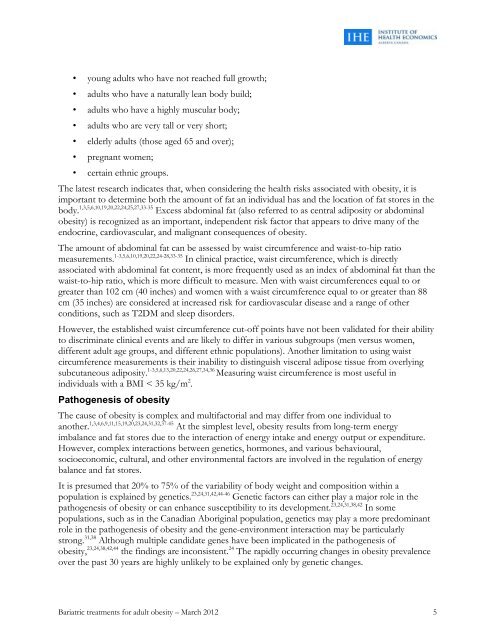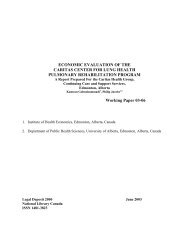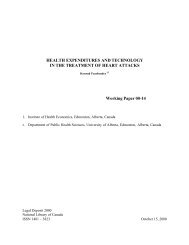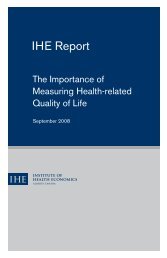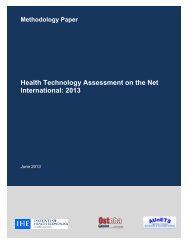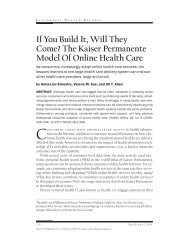This report addresses <strong>obesity</strong> in <strong>adult</strong>s only (≥ 18 years, both genders) and the condition is referredto here as <strong>adult</strong> <strong>obesity</strong>.Definition, classification, and description <strong>of</strong> <strong>adult</strong> <strong>obesity</strong>Obesity is defined as an accumulation <strong>of</strong> excess body fat (adipose tissue) that may impair one’shealth and may result in reduced quality <strong>of</strong> life (QoL) and increased morbidity and prematuremortality (www.who.int/mediacentre/factsheets/fs311/en/index.html, accessed 23 July2010). 1,2,5,6,11,13,14,16-27 A variety <strong>of</strong> methods have been proposed to measure body fat accurately orreliably, among which the most complex include densitometry, bioelectrical impedance analysis, dualenergy x-ray, and computed tomography or magnetic resonance imaging scanning. 1,2,10,13,19,28However, these methods require expensive equipment and highly trained pr<strong>of</strong>essionals and their useis not feasible in current practice.A common alternative is to define <strong>obesity</strong> as excess body weight rather than excess body fat(www.who.int/mediacentre/factsheets/fs311/en/index.html, accessed 23 July 2010). 1,2,5-7,11,13,14,16-27International and Canadian guidelines <strong>for</strong> body weight classification in <strong>adult</strong>s define <strong>obesity</strong> <strong>for</strong> bothgenders and all age groups in relation to body mass index (BMI), which is calculated as weight(expressed in kilograms) divided by height (expressed in meters squared, or kg/m 2 ). Within thisframework, the term <strong>obesity</strong> applies when the BMI is equal to or greater than (>) 30 kg/m 2 .As BMI is highly correlated with reference measures <strong>of</strong> body fat, it is widely used to indicatedifferent levels <strong>of</strong> health risks associated with <strong>obesity</strong> and to predict future health status in men andwomen (www.who.int/mediacentre/factsheets/fs311/en/index.html, accessed 23 July 2010). 1,2,6,9-14,16,17,19-22,24,27,29-31Because BMI varies greatly among <strong>adult</strong>s, <strong>obesity</strong> has been divided into three classes(class I or mild <strong>obesity</strong>; class II or moderate <strong>obesity</strong>; and class III or severe/extreme/morbid<strong>obesity</strong>), with successive values representing escalating health risk levels. According to the Canadianguidelines <strong>for</strong> body weight classification in <strong>adult</strong>s, which are in line with those <strong>of</strong> the WHO, <strong>adult</strong>sin class I (BMI between 30.0 kg/m 2 and 34.9 kg/m 2 ) have a high risk <strong>of</strong> developing healthproblems. 22 For those in class II (BMI between 35.0 kg/m 2 and 39.9 kg/m 2 ), the risk is very high.And <strong>for</strong> those in class III (BMI <strong>of</strong> 40 kg/m 2 or more), the risk is extremely high.Assessing body weight using BMI cut-<strong>of</strong>f points is simple and convenient; but it has a number <strong>of</strong>limitations because it does not take into consideration body composition. 1,2,5,6,9-13,16,17,19,22,24,25,27,30,32BMI does not measure body fat or the distribution <strong>of</strong> body fat directly and does not distinguish fatfrom fat-free mass such as muscle and bone. While it provides a useful surrogate <strong>for</strong> total adiposity,BMI is influenced by, and needs adjustment <strong>for</strong>, gender, age, and ethnicity/race. Because <strong>of</strong> bodycomposition differences, women generally have a higher percentage <strong>of</strong> body fat than do men andolder individuals tend to have a higher percentage <strong>of</strong> body fat than do younger <strong>adult</strong>s with the sameBMI. Furthermore, BMI classifications are based on the body types <strong>of</strong> those <strong>of</strong>Caucasian/European descent, which are different than Asian and Aboriginal body types. 1,22,30 ForAsian and Aboriginal populations, more research is needed to determine whether current BMIclassifications apply. 1,22For these reasons, although BMI is a good measure <strong>of</strong> <strong>adult</strong> <strong>obesity</strong> at the population level, it maynot be an accurate predictor <strong>for</strong> <strong>obesity</strong>-related health risks <strong>for</strong> certain groups because it does notcorrespond to the same degree <strong>of</strong> fatness in different <strong>adult</strong>s. 1,2,5,6,11,16,17,19,22,24,25,30,32 There<strong>for</strong>e, BMIbased<strong>obesity</strong> classification may underestimate or overestimate the effect <strong>of</strong> excess body weight andfat on health risks <strong>for</strong> some diseases in specific groups such as:<strong>Bariatric</strong> <strong>treatments</strong> <strong>for</strong> <strong>adult</strong> <strong>obesity</strong> – March 2012 4
• young <strong>adult</strong>s who have not reached full growth;• <strong>adult</strong>s who have a naturally lean body build;• <strong>adult</strong>s who have a highly muscular body;• <strong>adult</strong>s who are very tall or very short;• elderly <strong>adult</strong>s (those aged 65 and over);• pregnant women;• certain ethnic groups.The latest research indicates that, when considering the health risks associated with <strong>obesity</strong>, it isimportant to determine both the amount <strong>of</strong> fat an individual has and the location <strong>of</strong> fat stores in thebody. 1,3,5,6,10,19,20,22,24,25,27,33-35 Excess abdominal fat (also referred to as central adiposity or abdominal<strong>obesity</strong>) is recognized as an important, independent risk factor that appears to drive many <strong>of</strong> theendocrine, cardiovascular, and malignant consequences <strong>of</strong> <strong>obesity</strong>.The amount <strong>of</strong> abdominal fat can be assessed by waist circumference and waist-to-hip ratiomeasurements. 1-3,5,6,10,19,20,22,24-28,33-35 In clinical practice, waist circumference, which is directlyassociated with abdominal fat content, is more frequently used as an index <strong>of</strong> abdominal fat than thewaist-to-hip ratio, which is more difficult to measure. Men with waist circumferences equal to orgreater than 102 cm (40 inches) and women with a waist circumference equal to or greater than 88cm (35 inches) are considered at increased risk <strong>for</strong> cardiovascular disease and a range <strong>of</strong> otherconditions, such as T2DM and sleep disorders.However, the established waist circumference cut-<strong>of</strong>f points have not been validated <strong>for</strong> their abilityto discriminate clinical events and are likely to differ in various subgroups (men versus women,different <strong>adult</strong> age groups, and different ethnic populations). Another limitation to using waistcircumference measurements is their inability to distinguish visceral adipose tissue from overlyingsubcutaneous adiposity. 1-3,5,6,13,20,22,24,26,27,34,36 Measuring waist circumference is most useful inindividuals with a BMI < 35 kg/m 2 .Pathogenesis <strong>of</strong> <strong>obesity</strong>The cause <strong>of</strong> <strong>obesity</strong> is complex and multifactorial and may differ from one individual toanother. 1,3,4,6,9,11,15,19,20,23,24,31,32,37-45 At the simplest level, <strong>obesity</strong> results from long-term energyimbalance and fat stores due to the interaction <strong>of</strong> energy intake and energy output or expenditure.However, complex interactions between genetics, hormones, and various behavioural,socioeconomic, cultural, and other environmental factors are involved in the regulation <strong>of</strong> energybalance and fat stores.It is presumed that 20% to 75% <strong>of</strong> the variability <strong>of</strong> body weight and composition within apopulation is explained by genetics. 23,24,31,42,44-46 Genetic factors can either play a major role in thepathogenesis <strong>of</strong> <strong>obesity</strong> or can enhance susceptibility to its development. 23,24,31,38,42 In somepopulations, such as in the Canadian Aboriginal population, genetics may play a more predominantrole in the pathogenesis <strong>of</strong> <strong>obesity</strong> and the gene-environment interaction may be particularlystrong. 31,38 Although multiple candidate genes have been implicated in the pathogenesis <strong>of</strong><strong>obesity</strong>, 23,24,38,42,44 the findings are inconsistent. 24 The rapidly occurring changes in <strong>obesity</strong> prevalenceover the past 30 years are highly unlikely to be explained only by genetic changes.<strong>Bariatric</strong> <strong>treatments</strong> <strong>for</strong> <strong>adult</strong> <strong>obesity</strong> – March 2012 5
- Page 1 and 2: Alberta STE ReportBariatric treatme
- Page 3 and 4: Alberta STE ReportBariatric treatme
- Page 5 and 6: EXECUTIVE SUMMARYSocial and System
- Page 7 and 8: Three surgical procedures—adjusta
- Page 9: Costs of Bariatric Surgery and Pote
- Page 12 and 13: Regulatory status .................
- Page 14 and 15: TABLES AND FIGURESSection One: Soci
- Page 16 and 17: ABBREVIATIONSAll abbreviations that
- Page 18 and 19: LYMmMAMDMUHCNANHLBINHSNICENIHNNHNPH
- Page 20 and 21: Bariatric physician: a licensed Doc
- Page 22 and 23: High-density lipoprotein (HDL): a f
- Page 24 and 25: Very-low-calorie diet (VLCD): a die
- Page 26 and 27: Additional Internet searches were c
- Page 30 and 31: Many systemic factors have been ide
- Page 32 and 33: Severe obesity is associated with d
- Page 34 and 35: eport their height and under-report
- Page 36 and 37: Also using self-reported data from
- Page 38 and 39: An examination of overall obesity d
- Page 40 and 41: Table S.2 presents the associationa
- Page 42 and 43: • have multiple focal points and
- Page 45 and 46: The main problem in any weight mana
- Page 47: food, and a negative body image. As
- Page 50 and 51: directly causes death. 61 To the ex
- Page 52 and 53: The addition of a selected pharmaco
- Page 54 and 55: lack of formal training in nutritio
- Page 56 and 57: slightly more likely to have prescr
- Page 58 and 59: selection criteria, have facilities
- Page 60 and 61: Barriers to using appropriate baria
- Page 62 and 63: Overview of adult obesityOver the p
- Page 64 and 65: the need for regular physical activ
- Page 66 and 67: phenylpropanolamine/25. Sibutramine
- Page 68 and 69: Complianceand AdherenceDemand andut
- Page 70 and 71: Aetna Clinical PolicyBulletinswww.a
- Page 72 and 73: Overweight 123,821 172,971 157,623
- Page 74 and 75: REFERENCES1. 2006 Canadian clinical
- Page 76 and 77: 34. Gostin LO. Fast and supersized:
- Page 78 and 79:
69. Klarenbach S, Padwal R, Wiebe N
- Page 80 and 81:
105. Hill JO, Thompson H, Wyatt H.
- Page 82 and 83:
141. Ross R, Bradshaw AJ. The futur
- Page 84 and 85:
172. Arkinson J, Ji H, Fallah S, Pe
- Page 86 and 87:
This section will address a set of
- Page 88 and 89:
dietary therapy is to reduce total
- Page 90 and 91:
Additional benefits of exercise ove
- Page 92 and 93:
medications that inhibit intestinal
- Page 94 and 95:
Rimonabant may be considered for pa
- Page 96 and 97:
Long-term complications are specifi
- Page 98 and 99:
Devices used for bariatric surgeryH
- Page 100 and 101:
Description of the Included Systema
- Page 102 and 103:
AEs for sibutramineAs compared to a
- Page 104 and 105:
Evidence on Efficacy/EffectivenessW
- Page 106 and 107:
Table T.7: Effects of behavioural t
- Page 108 and 109:
SurgeryDescription of the included
- Page 110 and 111:
follow-up time was 3 years. Results
- Page 112 and 113:
group as compared to the VBG group.
- Page 114 and 115:
The authors identified many methodo
- Page 116 and 117:
The investigators pointed out that
- Page 118 and 119:
approximately 3 to 5 kilograms. For
- Page 120 and 121:
for studies with a mean age of part
- Page 122 and 123:
Examining whether use of any of the
- Page 124 and 125:
Evidence from placebo-controlled cl
- Page 126 and 127:
colorectal or gastroesophageal or f
- Page 128 and 129:
Web of ScienceISI Interface License
- Page 130 and 131:
AMA Clinical PracticeGuidelineswww.
- Page 132 and 133:
critical appraisal of the included
- Page 134 and 135:
APPENDIX T.B: EXCLUDED STUDIESTable
- Page 136 and 137:
Padwal R, Li SK, Lau DC. Long-term
- Page 138 and 139:
Quality subsection 1: At least MEDL
- Page 140 and 141:
Quality subsection 5a:Study quality
- Page 142 and 143:
Partially reported: The study types
- Page 144 and 145:
Table T.C.1: Results of quality ass
- Page 146 and 147:
Table T.C.1: Results of quality ass
- Page 148 and 149:
APPENDIX T.D: CHARACTERISTICS OF SY
- Page 150 and 151:
Table T.D.1: Characteristics of the
- Page 152 and 153:
Table T.D.1: Characteristics of the
- Page 154 and 155:
Table T.D.2: Characteristics of the
- Page 156 and 157:
APPENDIX T.E: EVIDENCE TABLE ON SAF
- Page 158 and 159:
Serious surgical complicationsSurgi
- Page 160 and 161:
LSGmMAMDNAnssORQoLRCTRDRRRYGBSBPTGV
- Page 162 and 163:
Table T.F.1-2: Weight loss - Behavi
- Page 164 and 165:
Table T.F.1-4: Weight loss - Surger
- Page 166 and 167:
Table T.F.2: Quality of life (QoL)
- Page 168 and 169:
Curioni & Lourenco 2005 58Cholester
- Page 170 and 171:
Table T.F.3-3: Risk factors/comorbi
- Page 172 and 173:
Table T.F.3-5: Long-term effects of
- Page 174 and 175:
Maciejewski et al., 2005 65Avenell
- Page 176 and 177:
Table T.G.2: Effects of bariatric s
- Page 178 and 179:
Table T.G.4: Effects of bariatric s
- Page 180 and 181:
18. Cerulli J, Lomaestro BM, Malone
- Page 182 and 183:
50. Health Canada Drug Product Data
- Page 184 and 185:
SECTION THREE: ECONOMIC EVALUATIONC
- Page 186 and 187:
Definition of bariatric surgical pa
- Page 188 and 189:
etween surgical interventions, the
- Page 190 and 191:
concluded that adding orlistat to L
- Page 192 and 193:
Weight management program (WMP) ver
- Page 194 and 195:
groups. Compared with standard care
- Page 196 and 197:
Results from Analysis of Provincial
- Page 198 and 199:
DiscussionThe objectives of the eco
- Page 200 and 201:
surgical suites, and so on. The bud
- Page 202 and 203:
APPENDIX E.A: LITERATURE SEARCH SUM
- Page 204 and 205:
CRD Databases(DARE, HTA & NHS EED)h
- Page 206 and 207:
Web of ScienceISI Interface License
- Page 208 and 209:
NEOS Librarywww.library.ualberta.ca
- Page 210 and 211:
Table E.A.2: Evidence table of revi
- Page 212 and 213:
ResultHealth outcomesCostsMarginal
- Page 214 and 215:
CostsMarginal analysisThe cost anal
- Page 216 and 217:
Time Horizon/discount rateCurrency/
- Page 218 and 219:
Objectivestudy perspective: society
- Page 220 and 221:
ResultHealth outcomesCostsMarginal
- Page 222 and 223:
ResultHealth outcomesCostsMarginal
- Page 224 and 225:
S4Economic burden of obesityMean co
- Page 226 and 227:
15. Lacey LA, Wolf A, O'shea D, Ern
- Page 228 and 229:
Author Contribution StatementsPaula


